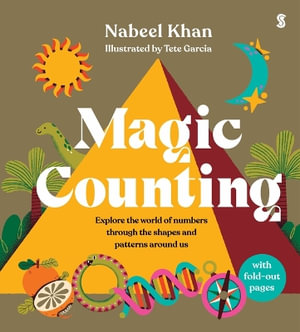Magic counting: Explore the world of numbers through the shapes and patterns around us by Nabeel Khan. Illus. by Tete Garcia

At first glance, Magic counting is a book for toddlers, with its board book format and bright colours, but once the book is opened and the flaps turned back, information about numbers is revealed that will intrigue adults and older readers.
The book opens onto the number One and on the left-hand side show the number, the world, a hand with one finger showing. On the opposite page is a globe with the words: 'One Earth turning, where countless creatures live’, and some information about Earth, all suitable for a young child. Turn the flap and magical knowledge awaits the reader regardless of age. The geometric shape of a circle and its properties are explained and then the reader learns about the ouroboros, a serpent that eats its own tail, the wheel with spokes of the same length and the enso, a Japanese Zen Buddhist symbol. The book continues in this way, with the numbers going to ten, the first two pages ideal for a young child, and then geometrical shapes and symbols that will expand the knowledge of all who read it. I was fascinated to learn about yin and yang for the number 2, the triskelion made of three interlocking spirals and used by ancient Greeks and Celts, and the wombat who makes square poo, made of four sides. I know that I will be looking at flowers in my garden to see if they have five petals and counting the segments in an orange to see if there are ten segments. And the illustrations in clear, bright colours complement the text and will help readers remember symbols and shapes.
Magic counting is an excellent way of linking numbers to everyday objects and expanding knowledge about shapes and symbols. Any person who is given this book or has access to it in a classroom or library is in for a treat. It is a keeper for me – just wonderful.
Themes: Counting, Shapes, Symbols.
Pat Pledger